Mine Action in Support of Yemen’s Peace Process
By Josh Ridley [ The HALO Trust ]
CISR Journal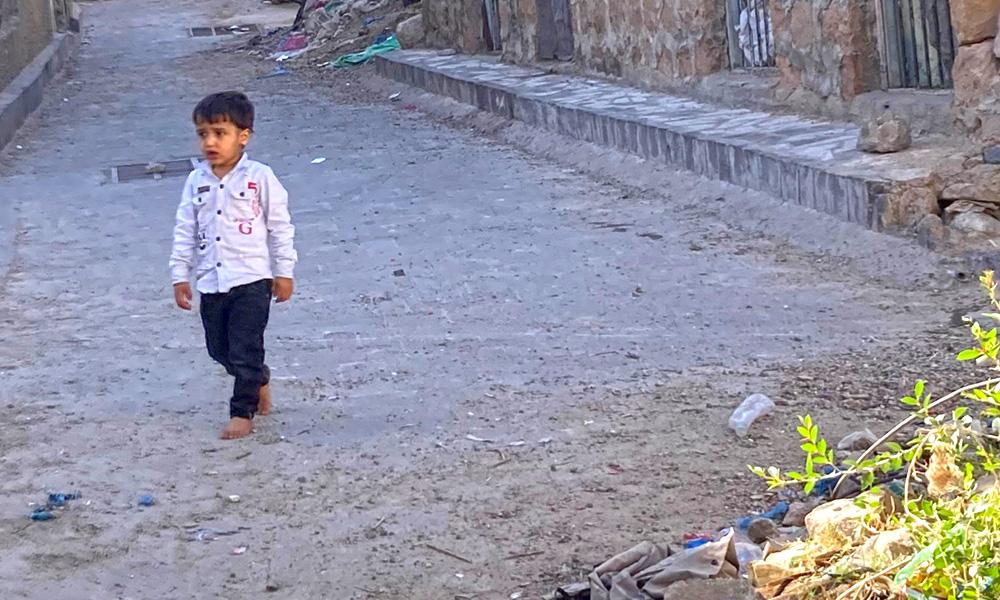
This article is brought to you by the Center for International Stabilization and Recovery (CISR) from issue 27.1 of The Journal of Conventional Weapons Destruction available on the JMU Scholarly Commons and Issuu.com.
Between April and October 2022, the two major parties of Yemen’s ongoing conflict, the internationally recognized government (IRG) and the de facto authorities (DFA), agreed to a truce brokered by the UN Office of the Special Envoy of the Secretary-General for Yemen (OSESGY). A central component of the UN-brokered truce included the re-opening of roads around Yemen’s third largest city, Ta’iz, which all parties agreed to in principle. While an expected extension of the truce did not go beyond October 2, there has not been a significant escalation in violence since the truce expired. The re-opening of roads in Ta’iz is likely to remain a key aspect of any future agreement.
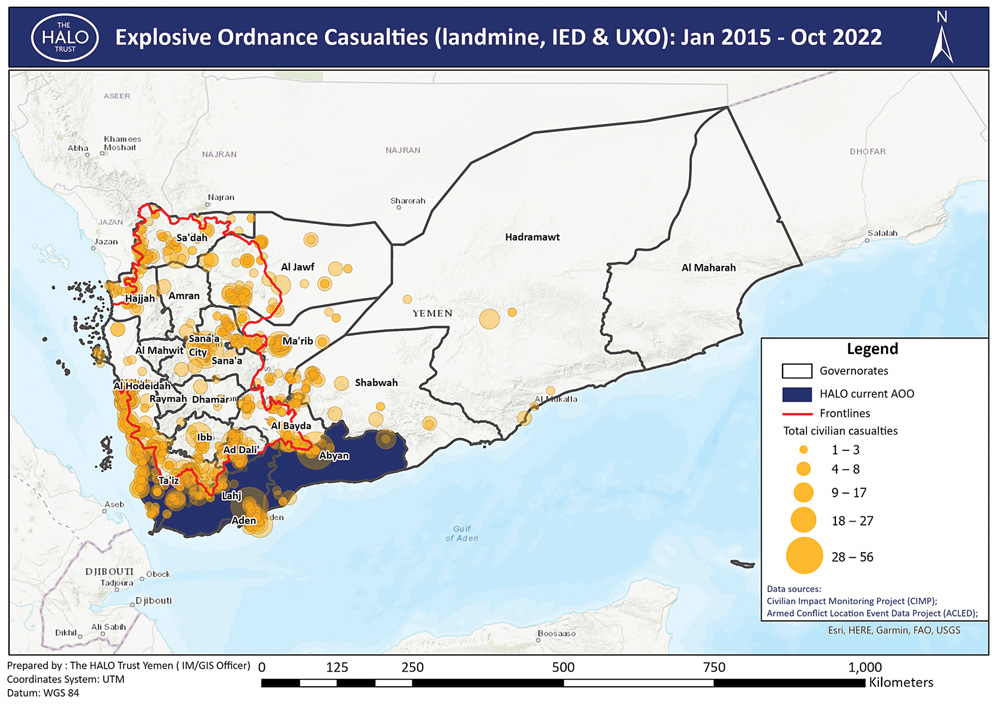
Data source: Civilian Impact Monitoring Project (CIMP) and Armed Conflict Location and Event Data Project (ACLED), which use publicly available open-source data of recorded EO accidents. Map is overlaid with HALO's area of operations (blue) and the IRG/DFA frontline (red). Map courtesy of The HALO Trust.
Once known as the cultural capital of Yemen, the war has bestowed a new title on Ta’iz—“the city of snipers”.1 It has been bisected by the frontline for the past six years, resulting in extensive landmine and explosive ordnance (EO) contamination, including the main roads spanning the frontline due to be re-opened under the truce agreement. The HALO Trust (HALO) has been operating in Yemen since 2019, and in support of peacebuilding efforts, from October 1, 2022, HALO began delivery of a comprehensive mine action response to facilitate the re-opening of roads in Ta’iz. As well as supporting the peace process, the initiative will mitigate an otherwise inevitable spike in EO casualties as increased freedom of movement and normality returns in a heavily contaminated city home to approximately 1,000,000 Yemenis. This article describes a tangible example of mine action making a direct contribution to stabilization and peacebuilding efforts at local and national levels.
Background and Yemen Mine Action Sector Overview
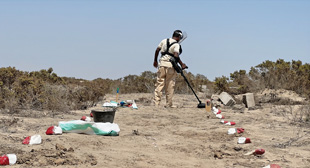
A HALO deminer sweeps a Minelab F3 detector on a minefield 4km north of Aden. Image courtesy of The HALO Trust.
Yemen is one of the most landmine- and EO-contaminated countries in the world, recording several thousand civilian casualties since the outbreak of the conflict in 2015.2 In addition to the toll on human life, extensive EO contamination is denying road access and the free movement of goods and people, community access to farmland, the delivery of critical humanitarian aid, and hinders the return of internally displaced persons (IDPs).3,4 Open-source data analysis highlights that the two governorates recording the highest numbers of civilian EO casualties are Ta’iz and Hodeidah, roughly equivalent to one known casualty per day. Data about EO-related casualties is patchy, so true casualty figures are likely significantly higher than what open-source datasets suggest.
Clearing mines and EO in Yemen is complex. HALO analysis has established a wide range of ordnance including at least thirty-seven different types of anti-personnel/anti-tank mines (including minimum metal mines), widespread cluster munition contamination in DFA territory, and an extensive improvised explosive device (IED) threat including reports of passive infra-red IEDs. As with casualty data, accurate estimates of Yemen’s EO contamination are hampered by a lack of survey data. However, the sector has made progress over the past two years with the roll out of a national baseline survey aimed at recording explosive hazards in all affected districts.
The international nongovernmental organization (INGO) mine action sector in Yemen is still relatively young, with most operators establishing programs in the last few years. While Humanity and Inclusion (HI) is the only mine action INGO registered and operational in DFA-controlled territory (in the northwest), those registered in IRG territory (the south and east) include HALO, Danish Refugee Council (DRC), Norwegian People’s Aid (NPA), and Humanity and Inclusion (HI). Non-INGO actors include the Yemen Executive Mine Action Centre (YEMAC), a governmental entity funded by the United Nations Development Programme (UNDP) which has been deploying teams across Yemen for over twenty years, and Project Masam, a Saudi-funded initiative.
Established in 2019, HALO Yemen’s operations span four governorates (Aden, Ta’iz, Lahj, Abyan) and include a broad spectrum of activities, including manual mine clearance and battle area clearance, non-technical survey (NTS), explosive ordnance disposal (EOD), and explosive ordnance risk education (EORE). The program also has two mechanical clearance teams, with a third to deploy shortly, which have cleared a large exploded ammunition storage area in the heart of Aden, approximately two hundred meters away from residential areas. HALO teams have to date destroyed over 135 tons of EO in and around Aden through clearance. The program pivoted its mechanical teams from bunker clearance to mine clearance activities in early 2023. The import of dual-purpose equipment, such as metal detectors and EOD equipment, has proven extremely challenging for INGOs in Yemen, delaying the deployment of manual mine clearance and IED disposal capabilities for the INGO sector.
As a national prerequisite, all INGO staff conducting clearance or EOD activities are seconded from YEMAC. This model is unusual for some operators and can create downsides but does provide more opportunity for ongoing training and mentorship of national operators than capacity development programs typically allow. The mine action sector is coordinated by the Yemen Mine Action Coordination Cell (YMACC), which was established in 2020 by UNDP. YMACC oversees prioritization, tasking, coordination, quality assurance, and information management across the mine action sector. Prior to 2020, YEMAC was performing the dual role of operator and coordination body.
Peacebuilding Through Mine Action – Ta’iz Road Re-opening
This year has seen increased optimism for peace and stabilization after the UN-brokered truce between all warring factions came into effect on April 2, 2022. The initial two-month truce was extended until it expired on October 2, 2022, due to disagreements between the parties involved. The truce brought about a sustained reduction in conflict and casualties which has continued, as well as increased humanitarian access to previously inaccessible areas.5 The reduction in violence is still broadly the case despite the truce not being extended. However, a key component of the truce, the re-opening of roads in and around the frontline city of Ta’iz, was not fulfilled. During the truce, a committee consisting of senior IRG and DFA representatives met on a regular basis along with OSESGY officials to seek agreement on which roads should be re-opened, as well as other considerations, such as when and how.
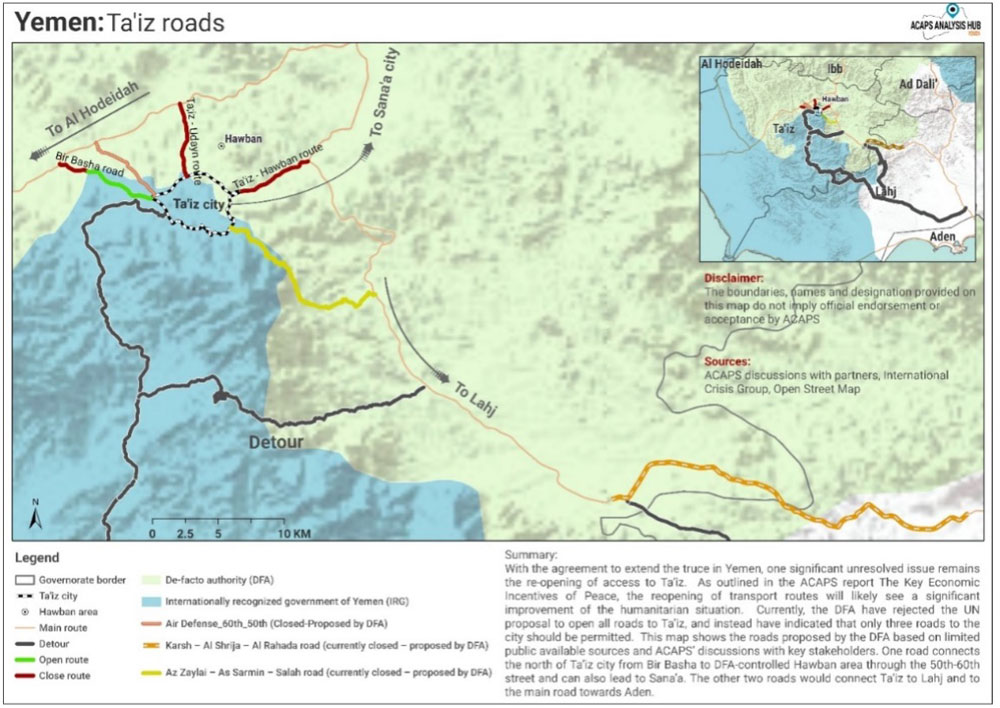
Figure 2. Location of Ta’iz city and major road locations in relation to the frontline between IRG and DFA forces.Figure courtesy of ACAPS Ayalysis Hub.
A major barrier to Ta’iz roads re-opening is widespread EO contamination on and around the roads, bearing in mind the six years of active conflict in the area. Numerous civilian EO accidents have taken place on the roads, which are now closed and/or scarcely used by the public out of fear for personal safety. While nobody denies the existence of a substantial EO threat, limited-to-no non-technical or technical survey activities had been conducted on or around Ta’iz roads prior to HALO’s project due to proximity to the frontline, making access challenging and hazardous. The reduction in violence during and since the end of the truce represents a window of opportunity to conduct mine action activities and gain a clearer understanding of contamination along and around Ta’iz roads. Such data is not only of use to the mine action sector but also to OSESGY, IRG, and DFA authorities to inform road re-opening coordination, in addition to benefitting other aid organizations and the wider international community.
While the truce was an undeniably positive development for Yemen, the resulting increased movement of people and the return of IDPs in Ta’iz and other frontline areas led to a significant spike in EO casualties.6,7 The second quarter of 2022 recorded the highest quarterly landmine and EO casualty count on record at the time, with 195 civilian casualties until the third quarter reported 228 EO casualties.8 Meanwhile, there are multiple reports of displaced people being forced to return to contaminated neighborhoods and homes in Ta’iz out of economic necessity. Without a comprehensive mine action response, the re-opening of Ta’iz’s roads, which lie in densely contaminated and populated areas, would only exacerbate the increase in civilian EO casualties and undermine the truce. An acute need exists for increased mine action support, not only for road clearance, but also in surrounding areas where high levels of civilian traffic will take place following road re-openings.
Objectives
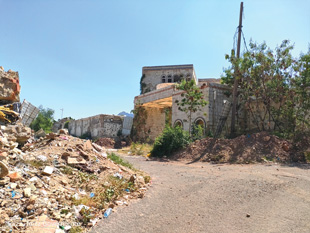
One of Ta’iz’s contaminated streets. An IED has detonated on the left of the image, destroying the side of the house. More contamination is suspected on both sides of the road. Image courtesy of The HALO Trust.
Thanks to funding from the Foreign Commonwealth and Development Office administered through Chemonics, HALO has deployed two mixed-gender multi-task teams prioritizing NTS, marking, and EOD activities in addition to EORE. Given the lack of existing data, NTS will be the project’s priority focus to enable follow-up clearance activities of confirmed and suspected hazardous areas as a phase two initiative conducted by HALO or other operators in early 2023. HALO has secured additional funding for the project and will likely scale-up capacity in early 2023, including manual and mechanical clearance; however, capacity is still far off the level required to address the extensive contamination.
HALO’s Ta’iz road mine action initiative sits at the triple nexus of humanitarian, development, and stabilization efforts. The project’s objectives are as follows:
- Stabilization and Peacebuilding: To enable the safe re-opening of Ta’iz roads to support parties meeting obligations of the UN-brokered truce. The prospect of restoring safe access to the roads will provide the parties with a common objective and a platform for dialogue between the IRG and DFA. Even if roads are not re-opened in the immediate future, survey, EORE, and EOD activities in previously difficult-to-reach areas will generate tangible positive results from the truce and recent dialogue between IRG and DFA delegations. Positive results from the truce will increase the likelihood of future collaboration and a truce, or a future peace agreement.
- Survey, assess, and report to all stakeholders the nature of EO contamination near and around Ta’iz roads: Survey data will enable the planning of clearance and other activities in advance of roads re-opening. Given the lack of previous mine action activities in the target areas, accurate characterisation of contamination will be vital to estimate funding requirements for clearance and inform the selection of roads to be re-opened by the IRG, DFA, and OSESGY. If survey finds no threat of contamination or clearance requirement in some areas, this alone is valuable information and could accelerate momentum for road re-opening efforts.
- Alleviate human suffering from EO: Given that existing high casualty rates will otherwise increase following roads re-opening, the project will minimize EO casualties through marking of hazardous areas, EORE delivery, and conducting EOD spot-tasks in heavily contaminated and populated areas. NTS will contribute to casualty reduction through enabling clearance of hazardous areas.
- Improve civilian access and livelihood opportunities: The safe re-opening of roads will improve access to affected neighbourhoods, helping to restore a sense of normality and providing a range of social and economic benefits. Increased freedom of movement will boost commercial activity, improving business opportunities and access to healthcare, education, and markets.9
Operational Approach
HALO teams have so far deployed to frontline areas in two of the three main districts of Ta'iz city: Al Qahirah and Salah (see Figure 3), targeting roads in Salah first. HALO has categorized roads and neighborhoods into the following order of priority:
- Roads provisionally agreed to be re-opened by IRG and/or DFA authorities
- Other roads previously discussed during committee meetings in Amman
- Roads of geographical importance that could be re-opened
- Other roads/surrounding neighborhoods where increased flow of people/traffic is expected following roads re-opening.
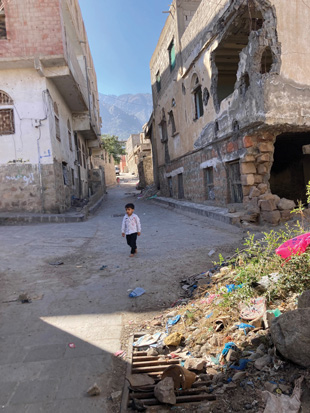
A child plays and roams around a grassy area that is a suspected hazardous area. Image courtesy of The HALO Trust.
Should access to the key roads be temporarily unavailable, teams will deploy to more accessible areas away from the frontline until access is granted. For similar reasons, the project target area is kept deliberately broad, anticipating fluctuating levels of security and access, and the need for flexible deployment in response to a range of possible outcomes of IRG/DFA negotiations.
Security and Access: A safe and permissive environment is crucial to the project’s success. Complex local and national dynamics make liaison vital to securing access for teams at several locations along the sometimes-volatile frontline. Access for HALO teams to sensitive militarized areas was considered to be the main challenge of the project; however, this has not been an issue to date. Indicative of the project’s need, HALO has strong support from influential people and decision makers in Ta’iz, including from the governor’s office, district managers, and local military forces. Through this support, HALO has managed to arrange audiences with military commanders on the frontline as key informants for NTS. Additionally, there has been significant high- and local-level engagement on the issue of the mine action response to date. OSESGY has coordinated negotiations with the joint military committee and the road committee, composed of representatives from both IRG and DFA, at talks held in Amman, Jordan.
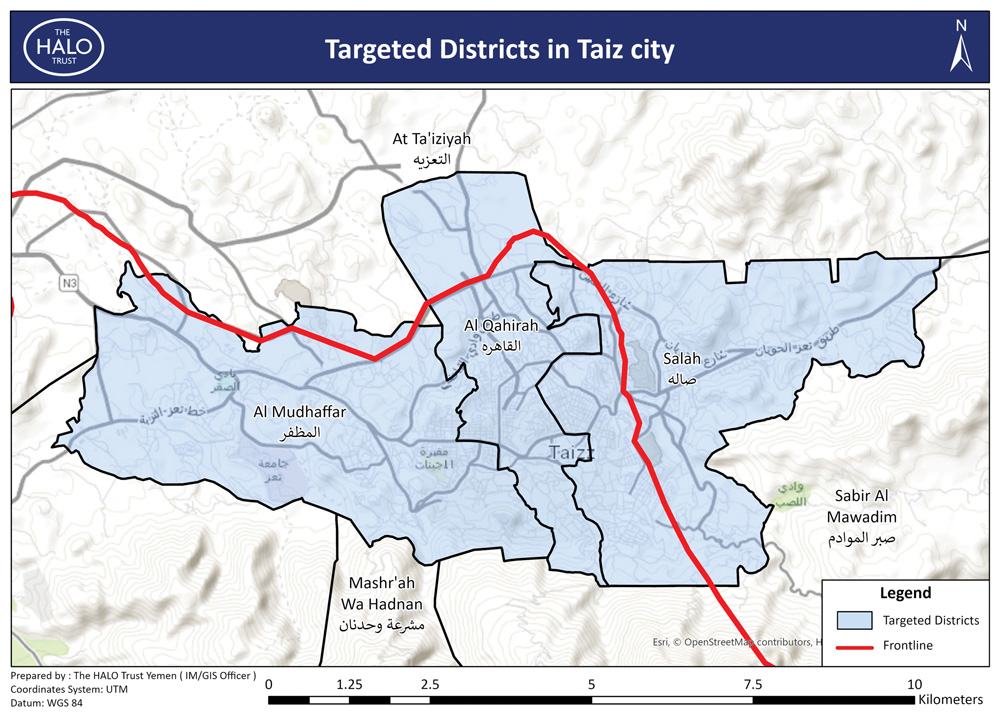
Figure 3. The three main districts of Ta’iz city where HALO’s activities will take place close to the frontline. Another key road runs southeast into Sabir Al Mawadin which the project anticipates working on in early 2023. Figure courtesy of The HALO Trust.
As a trusted, neutral NGO known by both sides of the conflict, HALO is well situated to access such sensitive areas. Several sources report that NGOs, as neutral humanitarian actors, are best placed to lead on mine action conducted as part of peacebuilding efforts.10 HALO’s previous mine action activities in the West Bank serve as a prime example. Additionally, anecdotal information from sources close to DFA military commanders on the Ta’iz frontline indicates DFA forces would not distinguish between YEMAC and the IRG military, given that YEMAC field personnel are military. The proximity of opposed forces in the urban setting raises unique security risks that require close management, with deployment of civilian personnel of considerably lower risk. As a result, HALO is only deploying civilian staff in these areas to maintain full neutrality and ensure conflict sensitivity.
Results
Securing access to the roads and surrounding neighborhoods was the project’s first priority in October 2022, which has gone smoothly to date. Channels of communication and ways of working with the multitude of stakeholders (including YEMAC, the military, government institutions, and district managers) involved in the project were agreed on. Despite a politically turbulent month (the truce expiring without extension) and with some minor flare-ups on the frontline and within the city, HALO deployed teams (following a thorough risk assessment) in target areas and began NTS and EORE activities. In their first couple of months, teams identified fourteen confirmed or suspected hazardous areas in densely populated areas and completed survey of two major roads which may be re-opened under a truce agreement. Being an urban context, hazardous areas are smaller than conventional rural minefields, with polygons ranging anywhere from 100m2 to 10,000m2. HALO teams are also clearly marking all identified hazardous areas to communicate the danger posed by contamination to communities and mitigate the risk of accidents, and have to date conducted fifteen spot tasks to dispose of EO.
From the first weeks of operations, the vast need for EOD clearance capacity in Ta’iz is abundantly clear. Teams have encountered several items lying in plain sight and residents are reporting EO on an almost daily basis, often storing items in their homes with children playing in the immediate vicinity. The lack of mine action presence in the densely contaminated city due to the previously active conflict and limited access is noticeable, and HALO will do its utmost to elevate capacity and attract new donor funding to the city. Similarly, HALO will seek to increase EORE capacity and has already started targeting schools in the city, reaching 3,500 beneficiaries by the end of November 2022. The lack of security and access has meant minimal risk education has been conducted in the city, despite being fiercely contested and under siege for almost seven years. HALO teams are reporting many recent accidents in the city, particularly on grassy verges next to roads, including two sisters who were seriously injured in a mine accident in October 2022. The storage of EO underscores an important role for risk education, both as a tool for raising awareness and for communities reporting EO to teams.
Timeline and Next Steps
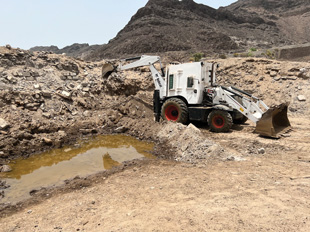
A Bobcat excavates a collapsed ammunition bunker in the heart of Aden city which exploded in 2015. Mechanical teams have cleared over 70 tons of EO across three collapsed ammunition bunkers, all of which HALO teams have destroyed. Image courtesy of The HALO Trust.
The primary priority of HALO’s current Ta’iz road project is NTS of the roads that are likely to be re-opened under any future truce agreement. Teams will also focus on neighborhoods and roads in proximity to the closed roads of interest and prioritize the most heavily contaminated parts of the city. Given the pressing humanitarian needs identified in Ta’iz and the scale of contamination, the program will seek further funding to increase NTS, EOD, and EORE capacity in the city in early 2023.
HALO anticipates starting clearance of Ta’iz’s hazardous areas in March 2023, following the completion of manual clearance training in the governorate which started in October. From the hazardous areas surveyed to date, deploying mechanical clearance teams in Ta’iz will be critical and the program will be able to draw from HALO’s urban mechanical clearance experience in countries such as Afghanistan, Libya, and Iraq.
HALO’s work in Ta'iz serves as an example of mine action’s multi-faceted contribution to peacebuilding and stabilization. While facilitating road re-opening as part of a truce agreement may be a unique circumstance, facilitating the return of IDPs, reducing high casualty rates, enabling socio-economic development, and supporting a return to normality for local communities are mine action’s bread and butter. Clearance of roads in Ta’iz, when re-opened, will enable free movement of people, access to previously inaccessible areas, and improve economic opportunities.11 Other domains for mine action to support peacebuilding are through employment and re-integration of ex-combatants, which HALO has conducted successfully in countries such as Afghanistan, and by using mine action as a platform for cooperation and trust building. Mine action is generally an under-utilized tool for stabilization programs. Through improved communication of case studies such as HALO’s Ta’iz road activities and improved messaging of the sector’s potential, the international community and mine action operators can work together more closely to facilitate peace and stability in fragile contexts.
Josh Ridley
The HALO Trust
Deputy Country Director, Yemen
 Josh Ridley is HALO’s Deputy Country Director in Yemen. Having previously worked in R&D in the pharmaceutical industry, he joined HALO in 2018 and has worked in Cambodia, Libya, and Afghanistan, in addition to Yemen. Outside of mine action, Ridley is a travel enthusiast and an avid mountaineer.
Josh Ridley is HALO’s Deputy Country Director in Yemen. Having previously worked in R&D in the pharmaceutical industry, he joined HALO in 2018 and has worked in Cambodia, Libya, and Afghanistan, in addition to Yemen. Outside of mine action, Ridley is a travel enthusiast and an avid mountaineer.
